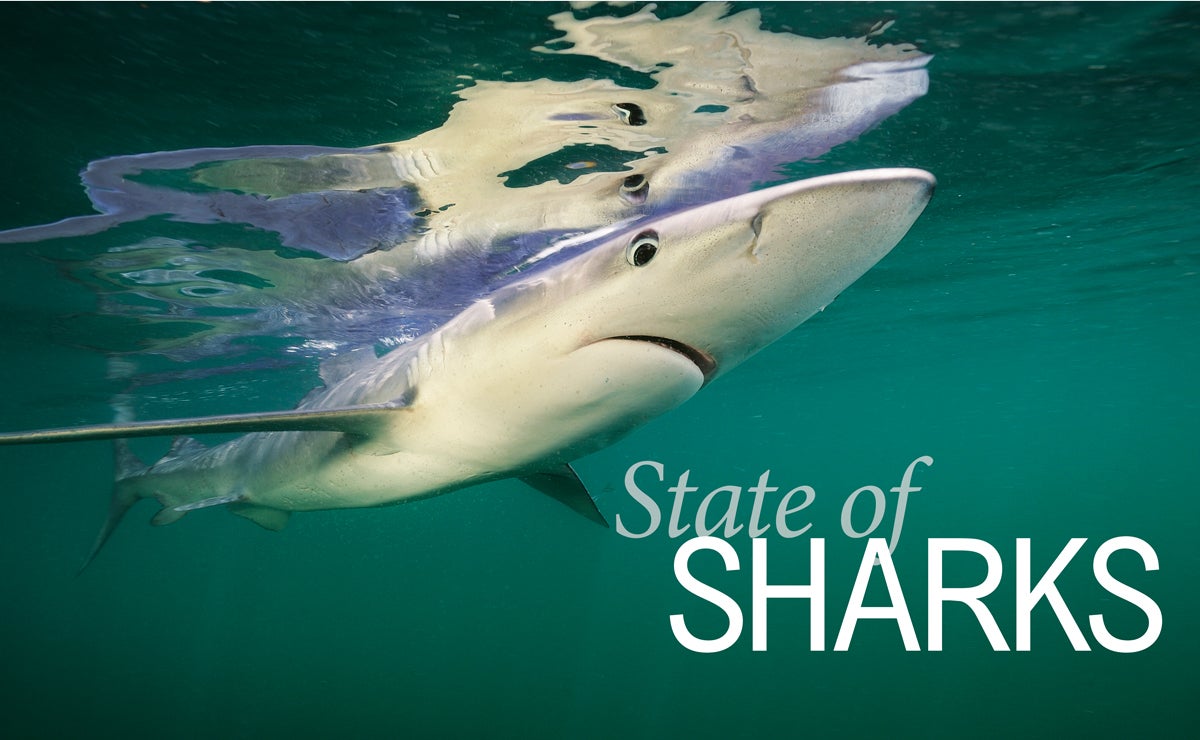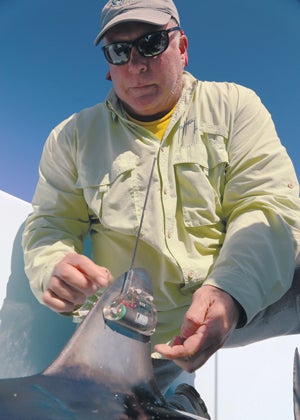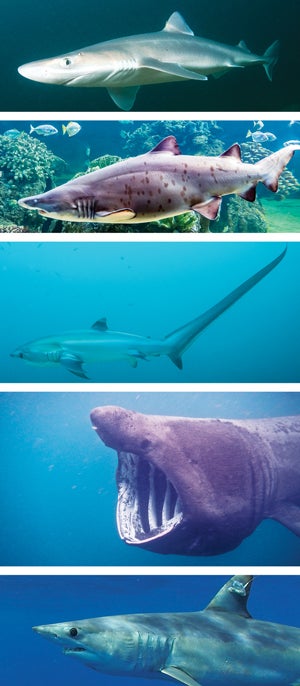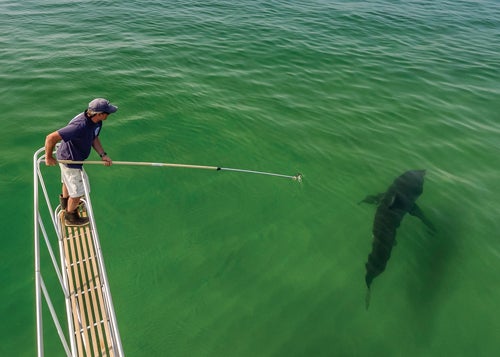
Some 50 different species of this most famous of marine predators regularly patrol the waters of coastal New England. Globally, shark numbers are dropping, but scientists say the news here is good—unless you’re a seal on Cape Cod.
By Todd McLeish
Most people are familiar with one species of shark: the misunderstood great white, made infamous by the movie Jaws and the Discovery Channel’s Shark Week. But more than 500 species of sharks ply the oceans of the world, and about 50 species can be found at one time or another along the East Coast, from the modest smooth dogfish to the massive basking shark. Many of them are studied by a handful of University of Rhode Island alumni and faculty—who tell a very different story about sharks than is conveyed by the popular media.
Unless you’re a fisherman or boater who spends considerable time in offshore waters, it’s unlikely that you’ll ever see a shark in southern New England, says Nancy Kohler ’77, Ph.D. ’87, along with Lisa Natanson Ph.D. ’90 and Camilla McCandless Ph.D. ’07. The three study the life history of sharks in the Atlantic Ocean and Gulf of Mexico for the National Marine Fisheries Service’s Apex Predator Program, based right next door to the URI Narragansett Bay Campus. They also conduct coastal surveys to monitor shark abundance, and collect biological data about sharks captured at recreational fishing tournaments.
A blue shark, Prionace glauca, swims in the Atlantic Ocean off the coast of Rhode Island. Blues, found worldwide, prefer deeper waters and migrate long distances. Feeding primarily on small fish and squid, they are the sharks most commonly caught by anglers off New England. They can grow to be 10 feet long at maturity, and rarely bite humans.
Greg Skomal videos a great white near a popular swimming area off Cape Cod. Carcharodon carcharias are found in coastal surface waters in all major oceans and can grow to 20 feet. A primary predator of marine mammals, they’ve been visiting the Cape, with its growing seal population, more frequently in recent summers. Worldwide, they are the species of shark most likely to attack humans, although the last fatal attack in Massachusetts was in 1936.
But sharks are here, they say. Lots of them.
They ticked off a long list of sharks that spend at least part of the year in the area: blue, mako, common thresher, sand tiger, smooth and spiny dogfish, basking, great white, porbeagle, and occasionally tiger, hammerhead and sandbar sharks. But the species most likely to be caught by fishermen in offshore Rhode Island waters is the blue.
“Blue sharks use different parts of the Atlantic for different parts of their life history,” explains Kohler, who studied the species for her doctoral dissertation. “This area is mostly a mating ground for them, which is why many of the larger sharks that fishermen catch are adult males. They pup on the other side of the Atlantic.”
One result of Kohler’s long-term tagging study of the species is a map of the impressive migrations they undertake—they travel through almost every part of the Atlantic Ocean. She says blues might, for instance, be tagged off New England and recaptured south of the equator, and they often return to the exact same place in local waters year after year.
Fishermen also catch a great many spiny dogfish, though few fishermen are happy when they do. The four- to five-foot sharks are often reeled in by recreational fishermen targeting cod and other groundfish. While there is little market for them in the U.S., Natanson said there is a regional commercial fishery for them to meet the demand for fish and chips in Europe.
Natanson, who recently started a study of the reproduction of dogfish, says spiny dogfish have a unique distinction among the sharks of the world. “They’re pretty small in the world of sharks,” she says, “but their two-year gestation is the longest of all the shark species.” That doesn’t mean they are necessarily slower to reproduce than other sharks, however. “Most sharks have a two-year reproductive cycle—they’re pregnant for one year and then they rest for one year,” she explains. “Dogfish also have a two-year cycle, but they don’t rest in between.”
All sharks can detect electromagnetic fields thanks to their extra sense organs, the ampullae of Lorenzini. Some are so sensitive that at close range, they can detect immobile animals by their heartbeat.
While dogfish are the most likely shark species to be captured close to shore and in lower Narragansett Bay, they aren’t the only ones. McCandless says commercial fishermen using fish traps in the bay sometimes catch small sand tigers and even small white sharks, and recent evidence suggests that sand tigers are regular visitors to Rhode Island’s coastal waters.
“We currently survey shark nursery habitat along much of the U.S. Atlantic coast and have plans to look at Rhode Island coastal waters for this purpose, and Narragansett Bay is an obvious fit for that study,” McCandless says. “We’ve done some exploratory sets in the Bay, and we’ve primarily caught dogfish and skates. We haven’t caught any sand tigers yet, but we know they come up here in the spring time, and they have been caught in fish traps in the Bay.”
One of the most charismatic sharks to visit southern New England waters is the mako, a species prized by fishermen and one that URI Professor Bradley Wetherbee has studied for many years. He and colleagues from Nova Southeastern University have tagged more makos in the Atlantic than any other scientists. Their research is aimed at learning about the health of mako populations, the migratory routes they travel, and the locations of the preferred feeding grounds for what he calls the “fighter jets of the shark world” for their swimming abilities.
He tracked one mako on a year-long, 6,500-mile migration in 2015 and 2016, but it was caught and killed a short time later by commercial fishermen off the coast of North Carolina. Sadly, it’s not an uncommon occurrence. More than a third of the more than 50 mako sharks he has tagged have been killed by fishermen.

Sharks on Campus
This summer, Brad Wetherbee launched a weeklong shark camp to provide under-represented high school students with an opportunity to learn about sharks, participate in a shark-tagging expedition, and get their first college experience this summer. He’s also working to establish an undergraduate shark research and education program based in the URI Department of Biological Sciences. A boat has been donated so he can take students on shark tagging trips and conduct shark surveys in southern New England waters.
“Students contact me all the time wanting to work with sharks,” Wetherbee says. “It would give them an experience they couldn’t get elsewhere, and it would be a great opportunity to conduct field work, study charismatic animals, and learn firsthand about the local marine environment.”
All he needs to get started is funding for gas, boat maintenance, fishing gear and bait. He is also looking for dock space. For more, visit uri.edu/wetherbee.
“Makos are caught in all kinds of fisheries all around the world,” he says. “They’re the shark everyone wants to catch because they’re good to eat—like a shark version of swordfish—and they fight and jump and put up a big battle. But it takes a great deal of effort and money to catch and track sharks. We don’t want to see our research subjects captured and killed, and lose their contribution to science.”
Wetherbee doesn’t object to shark fishing. In fact, his research is aimed at collecting information about the animals so they can be better managed and available for sustainable harvest for many years to come. He just hopes that any fisherman who catches a shark with a satellite tracking tag on its fin will release the shark back into the water unharmed.
The shark species that has received the most media attention in the region lately has been the great white, because their numbers have increased in recent years as they feed on the growing number of gray seals that breed on Cape Cod beaches. And caught up in the media frenzy has been Greg Skomal ’83, M.S. ’90, a shark biologist for the state of Massachusetts.
He has cataloged 258 great white sharks in southern New England since 2014, a number he says rivals other hotspots around the world where the species has been intensively studied. He is trying to get a sense for the total size of the population, what they’re doing while they’re here, and where they go when they leave the area—both to help conserve the species and to address public concerns.
“Our approach has been that the more we know about its population size and where it spends its time, the better equipped we’ll be to advise beach managers to enhance public safety,” Skomal says. “The public is worried, but they shouldn’t be. Attacks happen so infrequently. The probability is so low that their bigger concerns should be rip tides and car accidents.
“Many people are also fascinated by them, though,” he adds. “People come to the beaches hoping to see one. It’s been an eye-opening experience for me. I see a lot of positives coming from it.”
While most people are fearful of sharks, Wetherbee says sharks have much more to fear from people than people have reason to fear sharks. An estimated 70 million sharks are killed each year by commercial and recreational fishermen—mostly to meet the demand in China for shark fin soup—and there is concern that the rate is unsustainable.
Skomal said the greatest concern for global shark conservation is in countries far from the United States where harvest levels are high and there is little or no fishery management. “You really have to look at where it’s happening and what species,” he says. “If most of the harvest is in a certain region, then those sharks are in serious trouble. There is so much diversity in the shark world, though. Some species are prone to over-exploitation and others can be harvested sustainably.”
Sharks in U.S. waters, however, are being managed well, the scientists said, and the data suggest an optimistic outlook.
“The indexes are going up, indicators like our coastal survey have shown a steady increase, and even the shark fishing tournaments are regulated,” says Kohler. “I’m not seeing the doom and gloom here that we hear about elsewhere.” •

Spiny dogfish, Squalus acanthias, are shallow-water bottom dwellers that reach 5 feet. The market for them as food in Europe is rising.
Sand tigers, Carcharias taurus, are distributed worldwide. This relatively placid species can grow up to 10 feet and has no known human fatalities.
Common thresher, Alopias vulpinus, is named for its thresher-like caudal fin, as long as the body of the shark and used to stun prey. Up to 20 feet long, they have small mouths and are not known to threaten humans.
Basking shark, Cetorhinus maximus, is the second largest living fish, typically reaching up to 26 feet. It is a plankton eater.
Shortfin mako, Isurus oxyrinchus, the fastest sharks, grow up to 14 feet. The species most commonly targeted by fishermen off New England, both for sport and food, they are also a primary target of the global shark-fin trade. There were 42 human attacks documented globally between 1980–2010.
 Home
Home Browse
Browse Close
Close Events
Events Maps
Maps Email
Email Brightspace
Brightspace eCampus
eCampus



